“Before the parade passes by I’ve gotta go and taste Saturday’s high life. Before the parade passes by I’ve gotta get some life back into my life” from the soundtrack of Hello, Dolly!
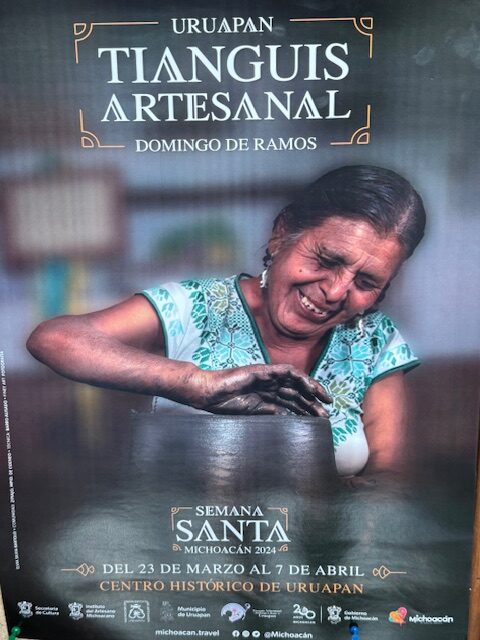
“Uruapan Tianguis Artesanal, Domingo de Ramos” or, the “Artisanal Market of Uruapan, Palm Sunday,” is an annual two week Easter extravaganza that takes over the second largest city of the Mexican state of Michocan , population: 400,000. It’s located at the western edge of the indigenous Purépecha highlands; about a four hour drive on toll roads.
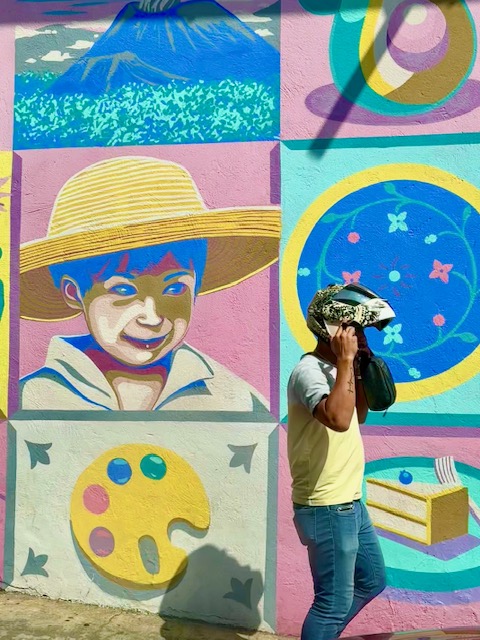
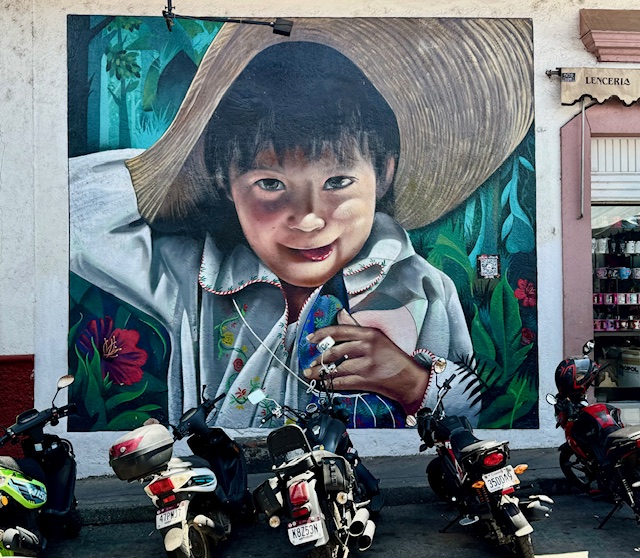

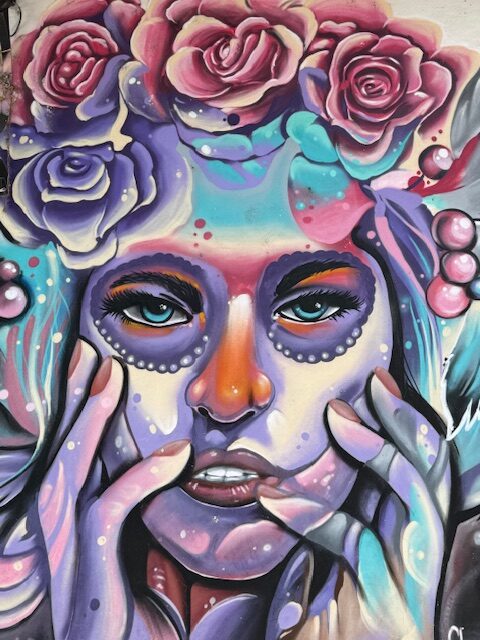
Uruapan, meaning “where the flowers abound,” is where most of Mexico’s avocado orchards are located, and is the central hub of year-round avocado production, harvest and exportation to the U.S. Your Super Bowl guacamole most likely originated from here.



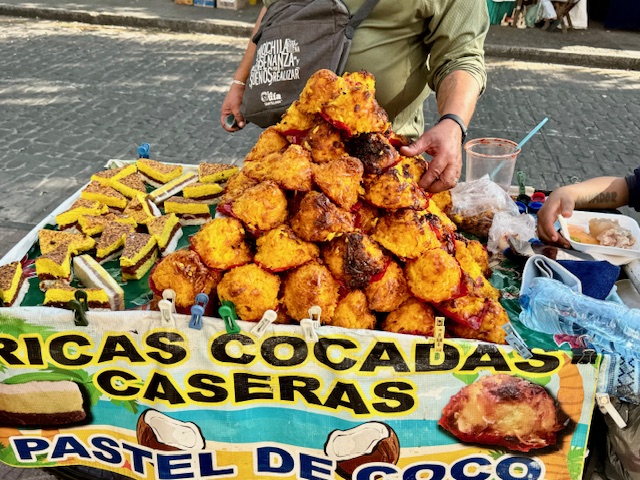
We had the opportunity to attend the Super Bowl of Mexican artisanal arts and crafts and competition (known as the Concurso). It’s the largest such event in the state that’s dedicated to the sale of its traditional handcrafts. It’s reputed to be the largest of its kind in Latin America and has been ongoing now for over 50 years.
Traveling southeast from Lake Chapala, we’d make a couple of stops before arriving at our hotel in central Uruapan …
Capácuaro is a small pueblo (pop. 6,600 at 7,400’ altitude), about nine miles north of Uruapan. A quick stroll through the town’s small market square provided the chance to see the Purépecha women and childrean colorfully dressed in their beautiful, bright and sometimes blingy native dresses. Lucky for us, we found a food stand serving up some very tasty and delicious al pastor tacos dorados, to hold us over ‘til lunchtime at …
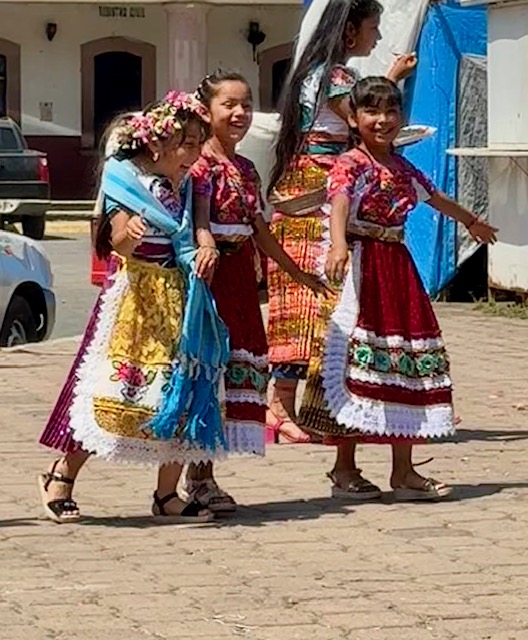

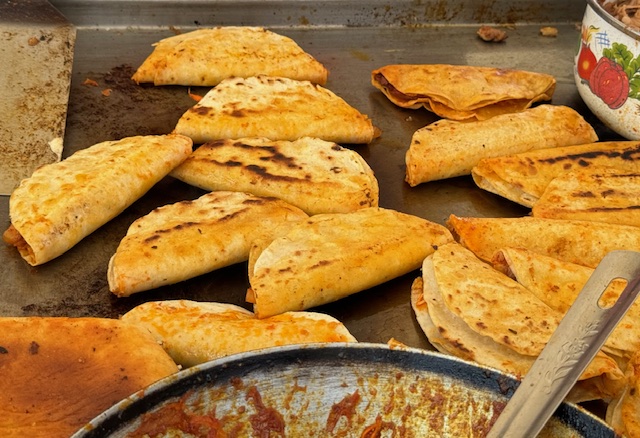


Gratissima restaurant, “La Casa del Aguacate” (The House of Avocado), located at the entrance to the Barranca del Cupatitzio National Park, the second most-visited national park in México. Despite being surrounded by the city, the park contains trees hundreds of years old, springs, streams, canals and walking paths for all to enjoy on a warm spring’s day.
The terraced patios of the open-air restaurant overlook the Cupatitzio River (“the river that sings”) at its source, and the waterfalls; so the roaring noise (“songs”) of the water helped increased one’s thirst and appetite.
The avocado reigns supreme in much of the menu – even in the making of their branded pale ale beer; using the essence of the leaves and flower’s honey.
We enjoyed a delicious, traditional Mexican Tarasca soup, yummy Jalapeño Poppers and Shrimp Cocktail chock full of avocado. One can never get enough of the mighty avocado. Even the napkin holders stuck to the theme!

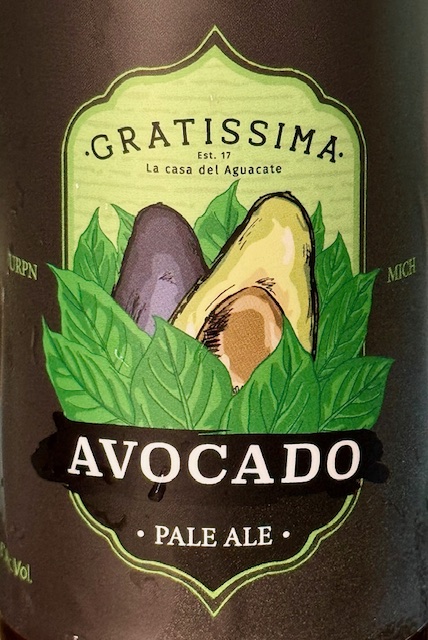
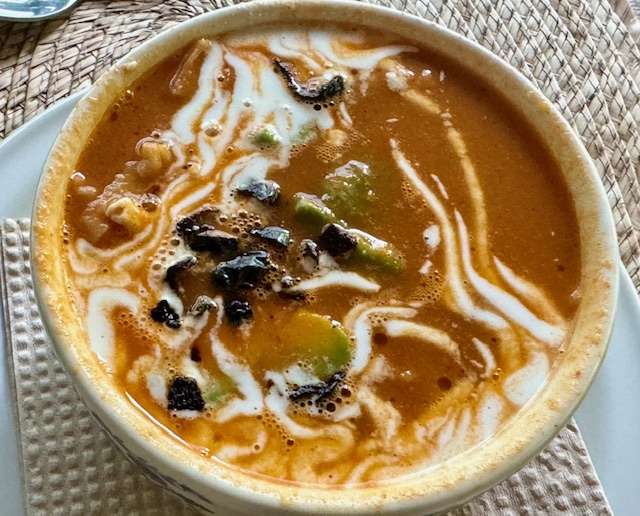

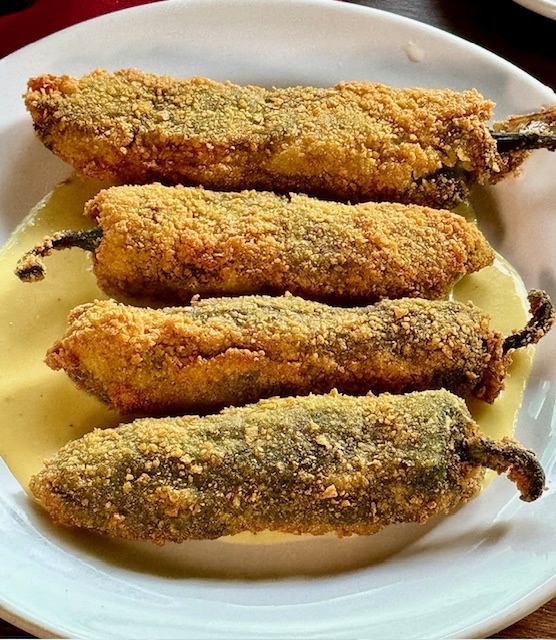
The Aztecs thought them to be an aphrodisiac, or source of strength and/or fertility. The Spanish name, Aguacate, derives from the indigenous Nahuatl word for “testicle” – for they grow in pairs.
After lunch, we took a stroll through the park, where the focus is on the conservation of the ravine which forms the headwaters of the Cupatitzio River. It’s fed by various springs and streams starting with the “Rodilla del Diablo” (Devil’s Knee), the exact place of the river’s source .
According to local myth, Juan de San Miguel forced the Devil to bow before the Cross, with the Devil’s knee making an indentation in the rock from which the first spring emerges. The land was private until the 1930s when the federal government bought it to create the park.
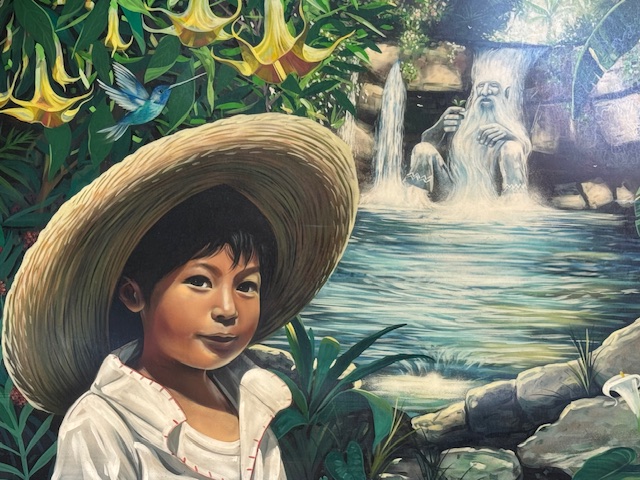
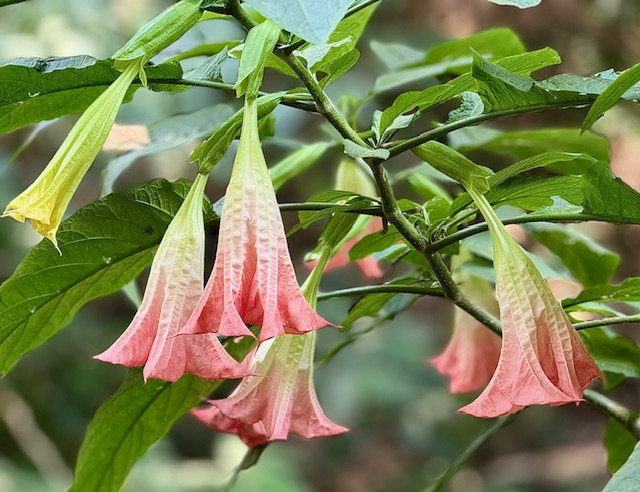
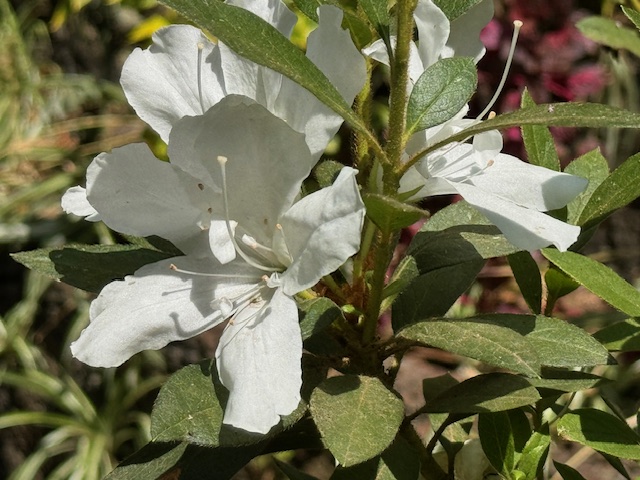
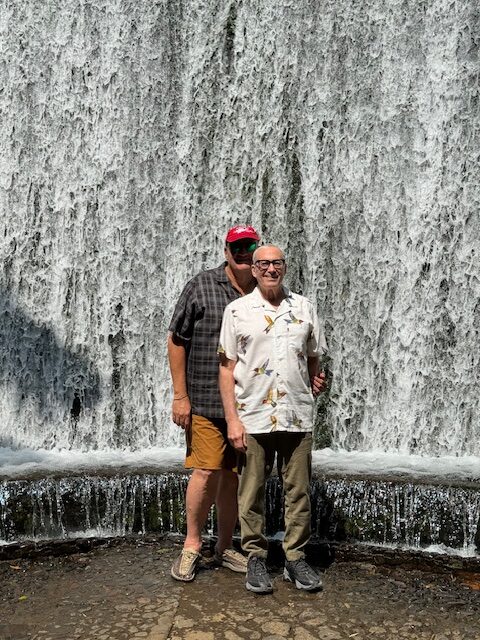
URUAPAN
Uruapan Tianguis Artesanal (artisan’s market), is held in the Main Plaza, and attracts visitors with its wide variety of artisans and craftspeople from throughout the state. There, one can find a wide variety of creative and unique folk art and assorted wares: ceramics and pottery, textiles and clothing, miniatures, jewelry, toys, lacquerware, leather goods, grass/straw, metal and wood furniture, copperware, masks, guitars, and the famous “little devils” of Ocumicho.
Most items for sale are of high quality and styling found only in Michoacán, such as clay pots from Huancito with animal heads; needlework, from Cherán; pre-Hispanic lacquerware (maque) from Uruapan; copper pieces from Santa Clara del Cobre, and wooden masks from Pamatacuaro.
Another interesting item you’ll find if you go on or before Palm Sunday, is watching the plethora of nimble fingers busily weaving palm fronds into crosses and intricate shapes for the holiday, symbolizing victory and peace; otherwise, “idle hands are the devil’s playthings.”
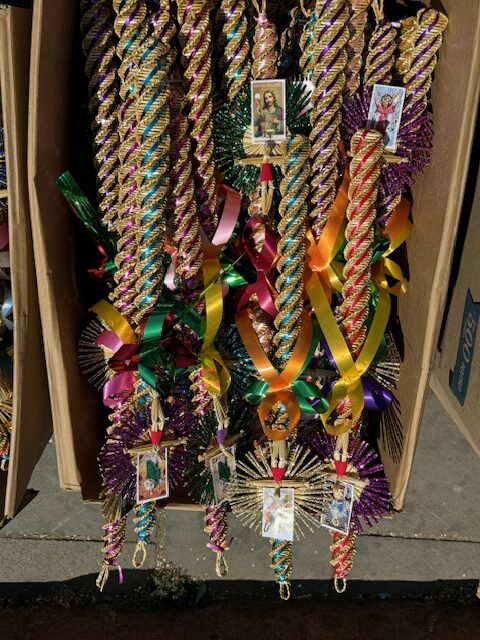
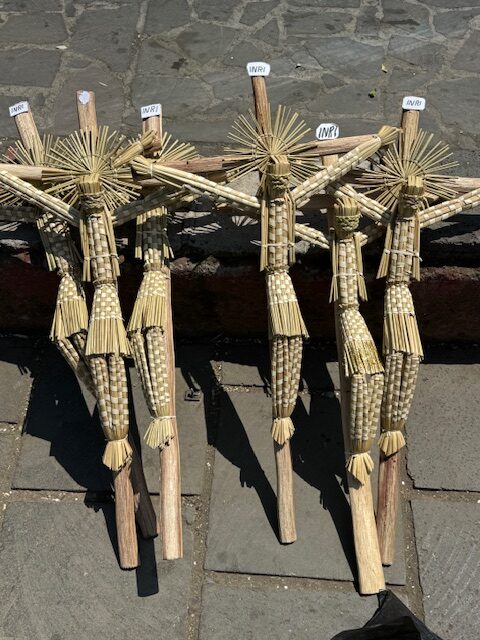
For many, the show is a culmination of a year’s creative production of art pieces, providing the bulk of their annual income. It also gives them an excellent exposure to a larger market.
As mentioned above, we eagerly sought out the famous “devils” of Ocumicho. Its 3,600 inhabitants live off the little devils, primarily created by women, with each and every little guy individually made, and not from a mold. David was looking for a “devil’s car,” while I just nonchalantly browsed the vast displays.
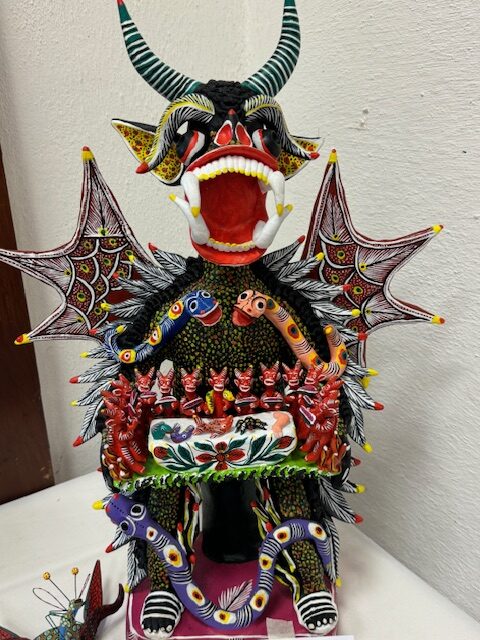
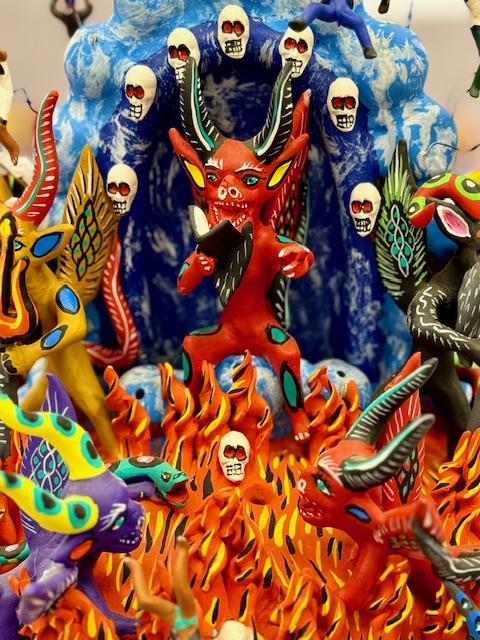

Then “The Bull and the 13 Devils” came along and struck my fancy, with its powerful, massive appearance, standing 13 3/8” tall, and weighing just over 4 lbs. I can’t exactly say why, but I couldn’t keep my eyes off of it. David reminded me that if you see something you like, buy it; chances are it won’t be there the second go-round. As they say, “You snooze, you lose!”
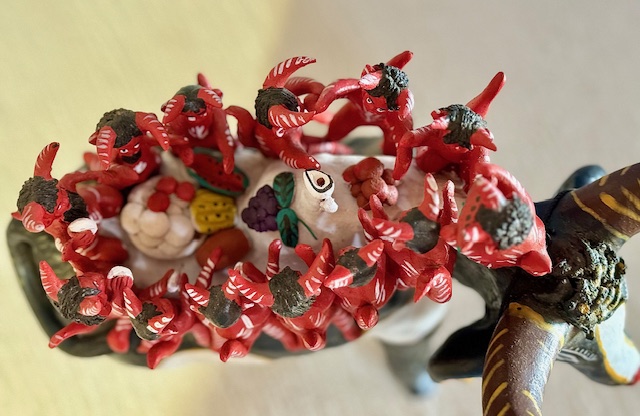


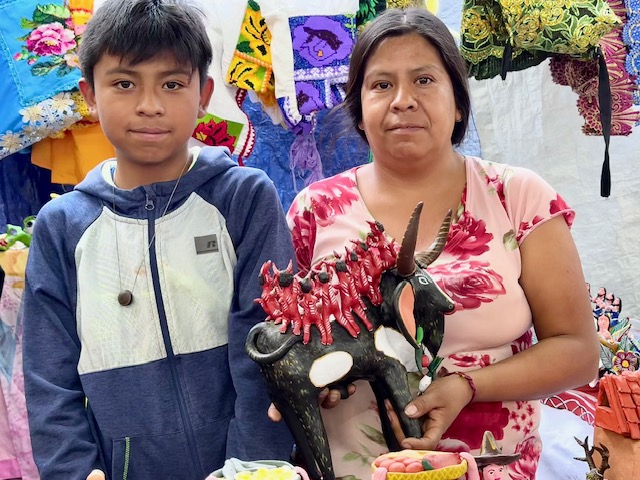
Its imaginative creator, Olivia Elias Julian, graciously signed the bull’s flank and I was a happy Toreador. If per chance, anyone would like to offer up any further interpretations on the significance of this odd devilish feast gathering, then please chime in; your theory is as good as anyone’s.
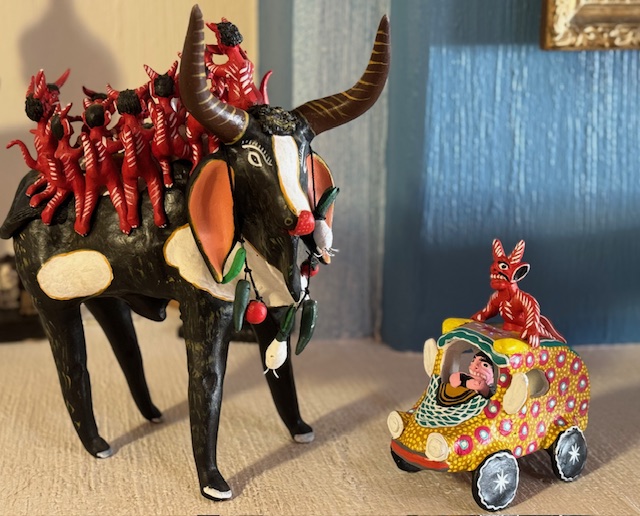
The following day we took another pass-through of the market in the hopes of finding David’s devil car. And there it was ~ a yellow dotty vehicle with its hapless and bedeviled driver with the red devil along for the ride.
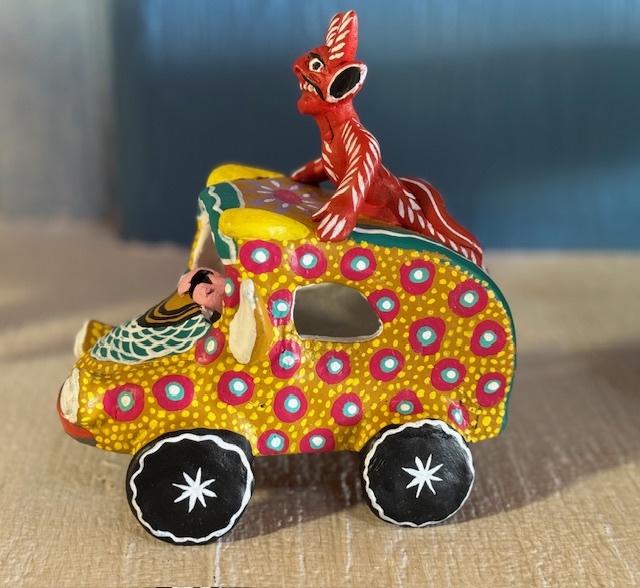
What’s so great about the Uruapan Market Fair is its promotion of the four main indigenous cultures of the state: the Purépecha, Mazahua, Nahua and Otomi. The Purépecha are best represented, not only because they are the dominant group, but also because handcraft production has been highly developed in their region since both the pre-Hispanic and colonial periods.
Here then is a little bit of historical background … Uruapan was conquered by the Spanish in 1522, when the last Purépecha ruler fled the Pátzcuaro area to arrive here. The city was laid out in 1534 by Friar Juan de San Miguel; the same founder of San Miguel de Allende. Uruapan would play a key role in the War of Independence and was the capital of Michoacán during the French Intervention (Morelia is the present capital).
Throughout the festival weeks, other events take place: a handcraft competition, exhibition of indigenous dress, food and other traditions, musical concerts, dance and more. There’s a main stage set up in the church plaza, but the festivities spread out to adjoining streets and other plazas.
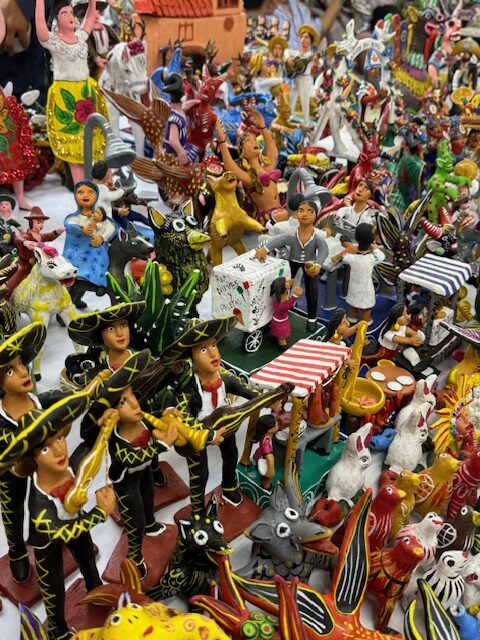
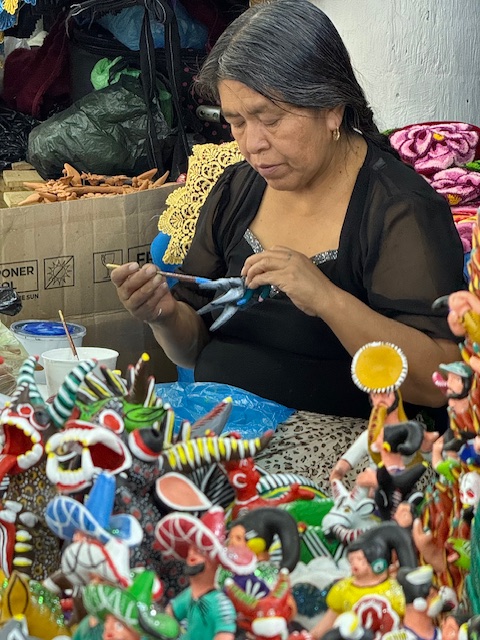
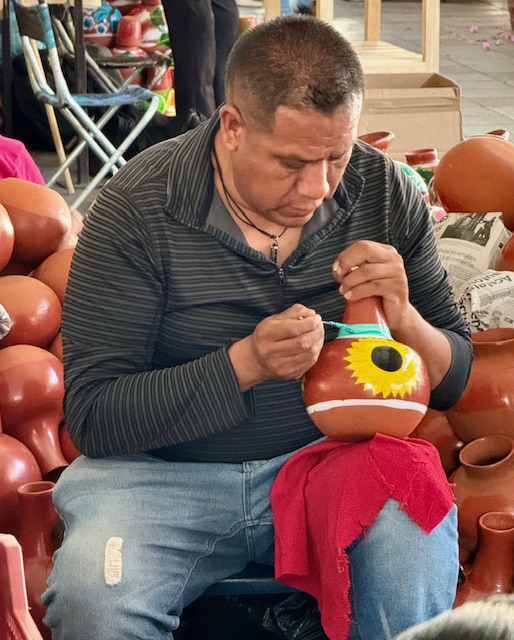
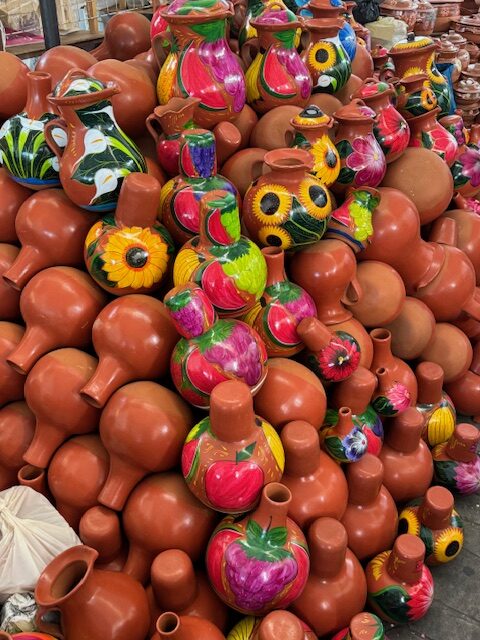
We walked about the city’s historic center, marked by the large, 16’ marble obelisk in the Plaza de Martires de Uruapan. Facing this plaza are two commercial portals as well as some of the city’s most important landmarks, one being …
The Parroquia de San Francisco de Asís (St. Francis of Assisi Parish), with its light pink façade, built in 1533, and features a 16th-century Plateresque portal (elaborate ornamentation), and its interior has a crucifix that dates from the 18th-century.
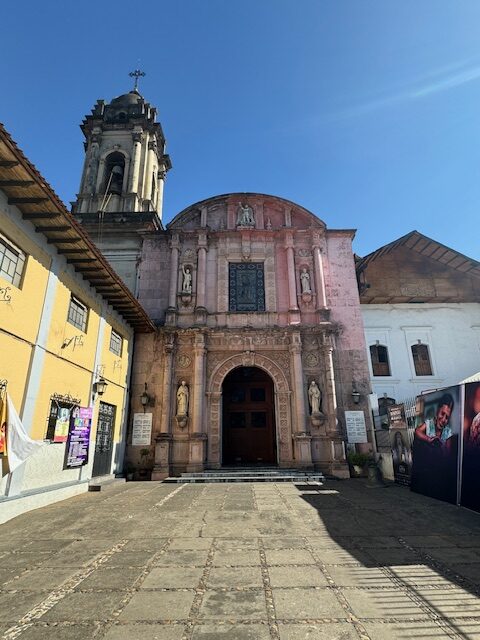
The interior dome features four unusual, breathtaking, modernistic paintings on its triangular spaces, aka pendentives. They represent salvation and the miracle of the Mass, and were created by Iranian artist, Mohamed Sciddel (1939-2013), in 1968-69. Sciddel came to live in Mexico after the Iranian Revolution of 1979.
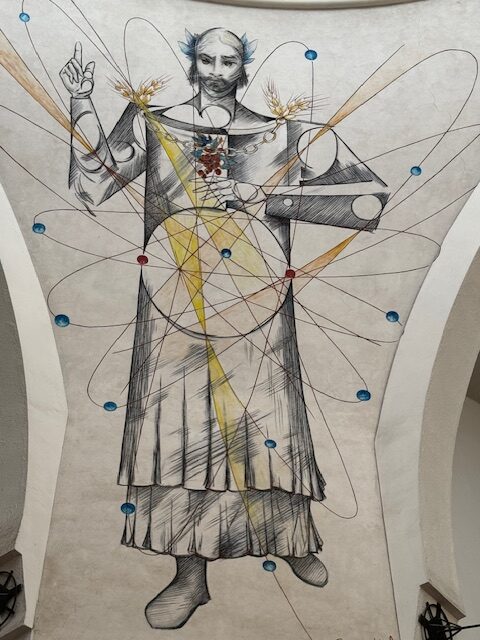
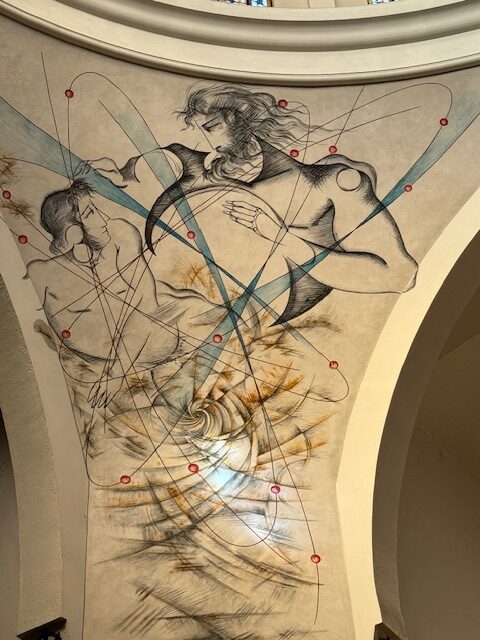
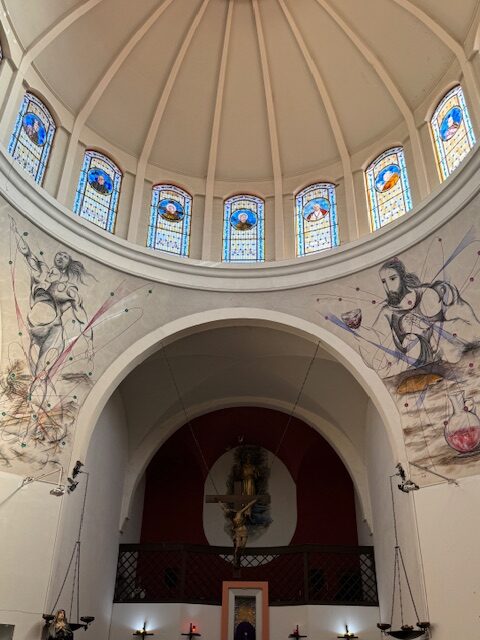

Just steps from the plaza is La Casa de Cultura (cultural center) that was hosting the juried artisans’ work. Luckily, we were privy to a preview invitation of seeing the best of the best, with the contest ribbon-winning pieces on display and for sale. No trinkets here; only the best of the Maestros were presented.
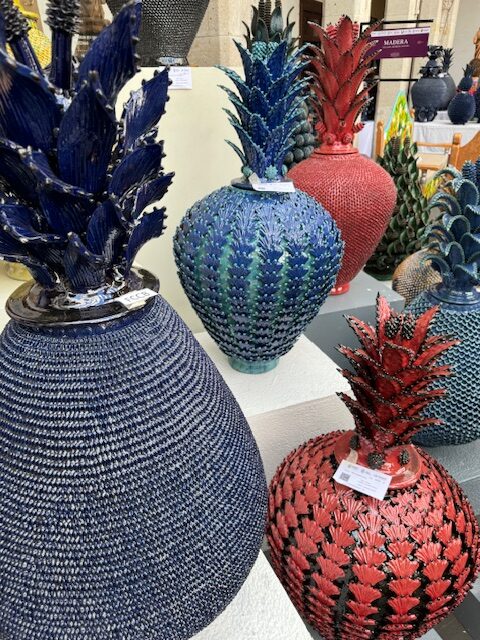
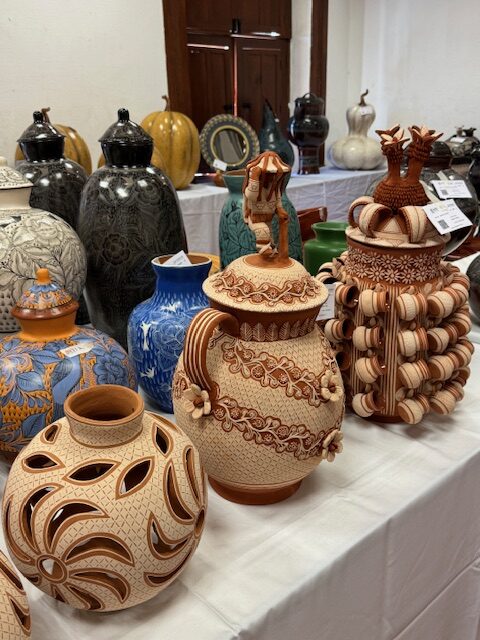


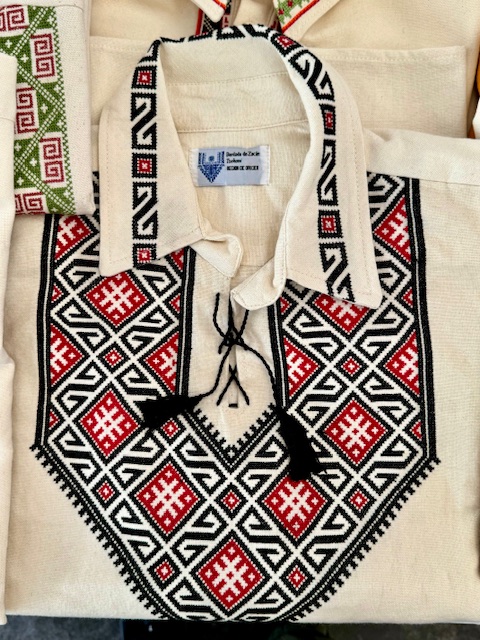

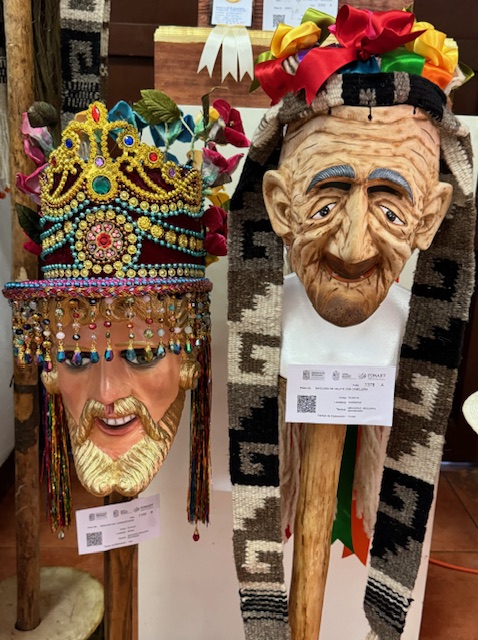
Surrounding us in the bright, open atrium was an incredible array of creative work. One’s eyes would quickly dart from one striking piece to another in many different categories and mediums. What to buy with so many exciting works? One particular ceramic bowl “spoke to us” and happily followed us home for a permanent place on the coffee table.
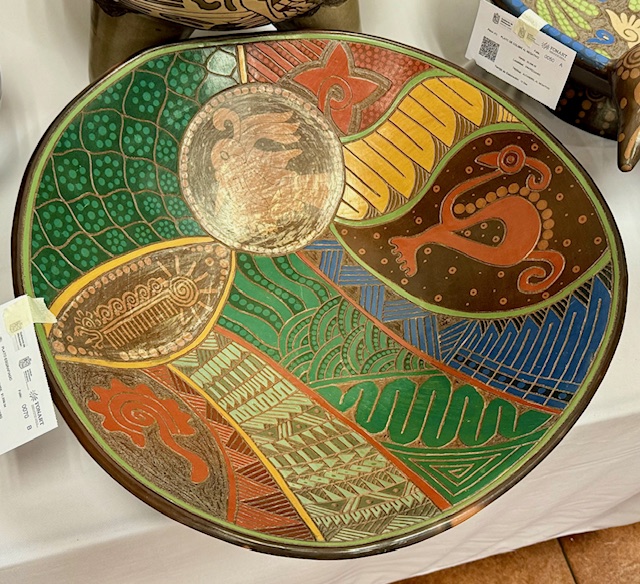
With shopping completed, it was time to eat. Sadly, a food search for Michoacan’s famous Tacos Carnitas (see the “Tacos Chronicles” on Netflix), proved fruitless at El Mercado de Antojitos (snack market); for being a lapsed Catholic, I’d forgotten about meatless Fridays during Lent. Not a single stall had a speck of carnitas available. ¡Qué lástima!

With our physician’s recommendation, we had an afternoon coffee break at the nearby Café La Lucha, a 100-year old local institution. Let me tell you that their coffee alone is a good enough reason to visit Uruapan, but the crown glory is their Choco-Menta cold drink, which I sipped slowly, not wanting to finish it off. It was a delicious and refreshing chocolate drink, the likes of which I’ve never tasted before, un milagro en un vaso (a miracle in a glass). We couldn’t leave without buying a kilo of their famous and flavorful, dark-roasted coffee beans @ $14.40 for 2.2 lbs. A great souvenir to savor and enjoy at home.
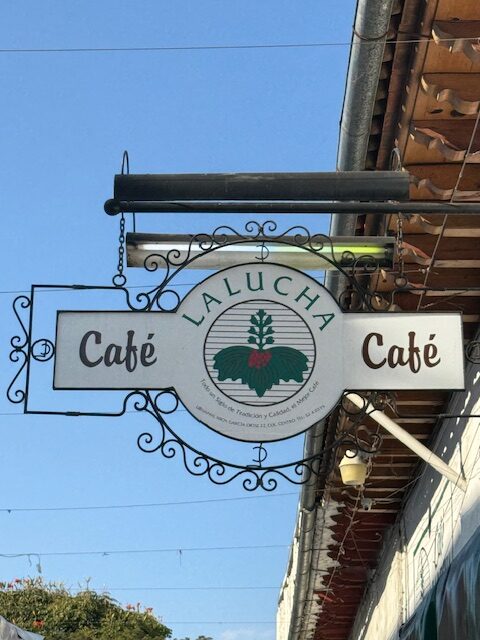

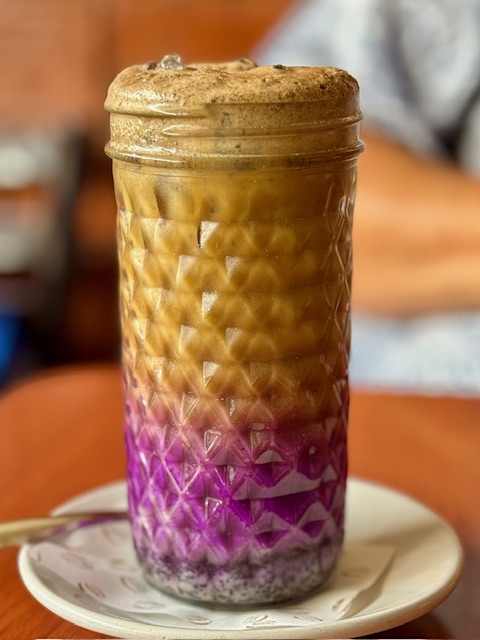
Later in the day, we had a private demonstration by a Maestro in the art of maque or Mexican lacquerware, one of the country’s oldest crafts. In pre-Hispanic times, a greasy substance from the Aje larvae and/or oil from the chia seed were mixed with powdered minerals to create protective coatings and decorative designs in the lengthy process.
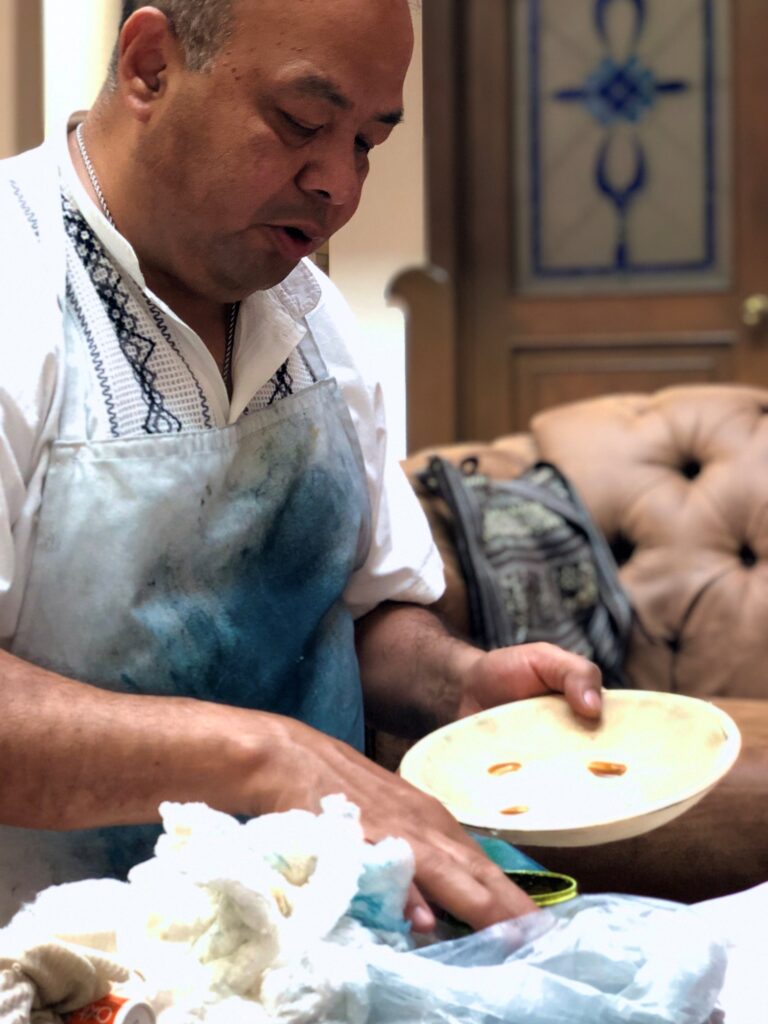
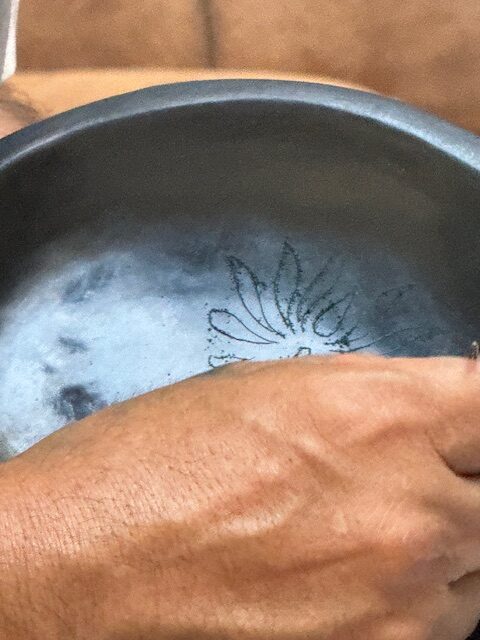
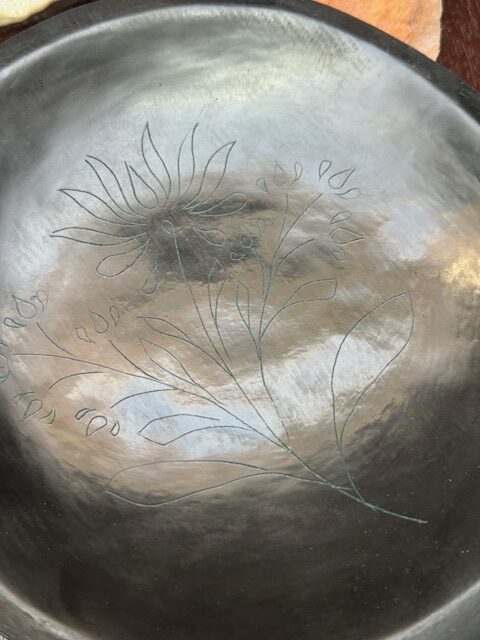
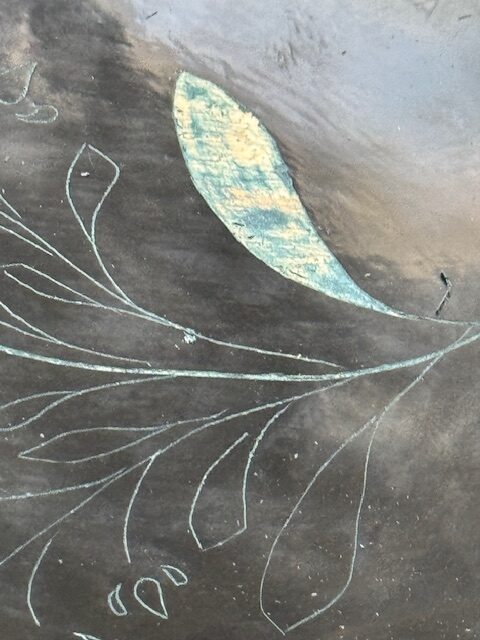
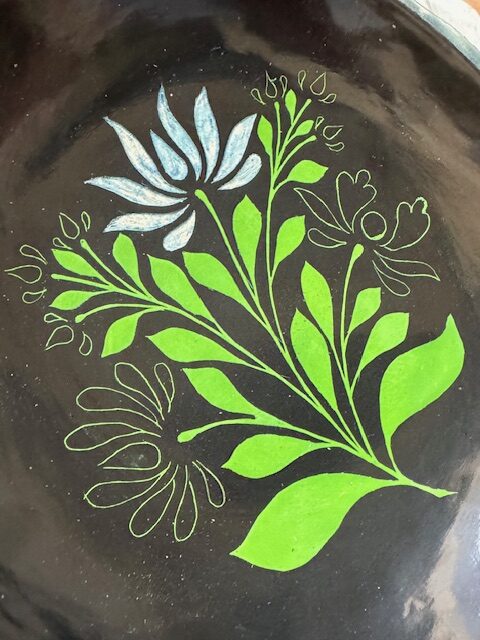

During this period, it was applied to dried gourds, especially to make the cups that Mesoamerican nobility drank chocolate from. After the Conquest, the Spanish had indigenous craftsmen apply the technique to European-styled furniture and other items; changing the decorative motifs and color schemes, but the process and materials remained mostly the same.
THE PARADE OF ARTISANS!


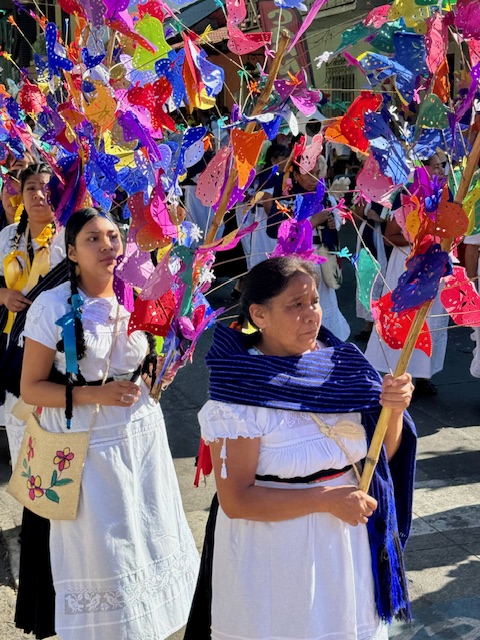


It’s Saturday morning and the anticipation builds and fills the air as the pièce de résistance, and highlight of the Market Fair – the Parade of Artisans is about to begin! It’s a spectacular, colorful extravaganza that brings together craftsmen and women, and their townsfolk from across the state.



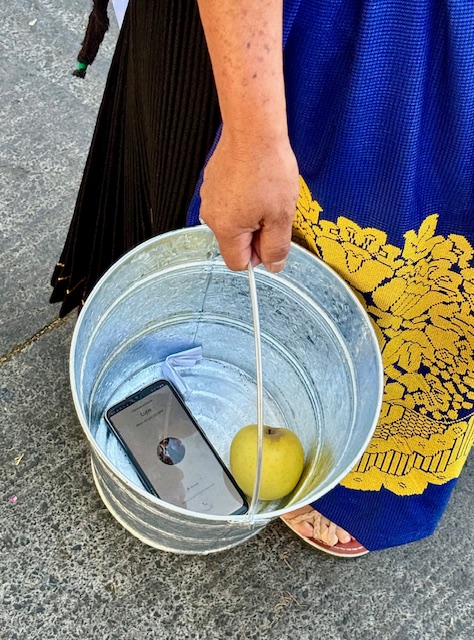

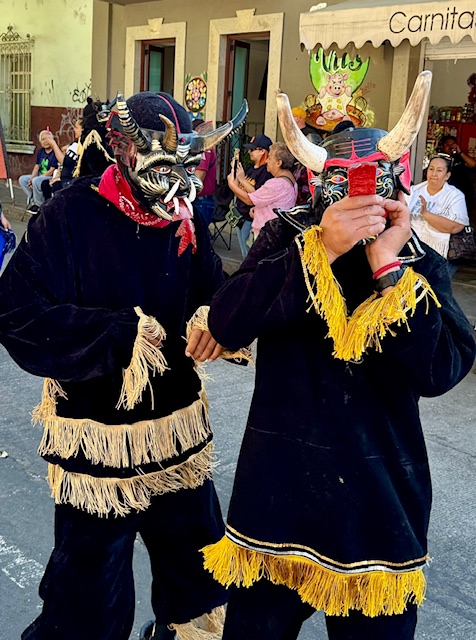
They’re garbed in their vibrant native dress, highlighting their talents and local traditions. One after another, the Bandas pass by, blasting trumpets, sounding the rich, deep bass of tubas, beating drums, strumming guitars, and serenading bystanders with their lively beats.
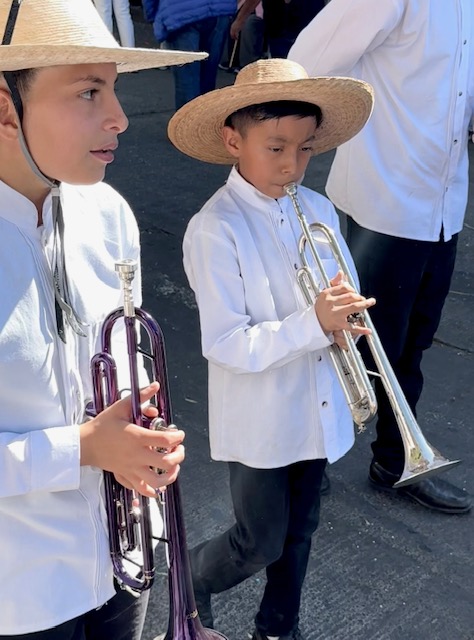
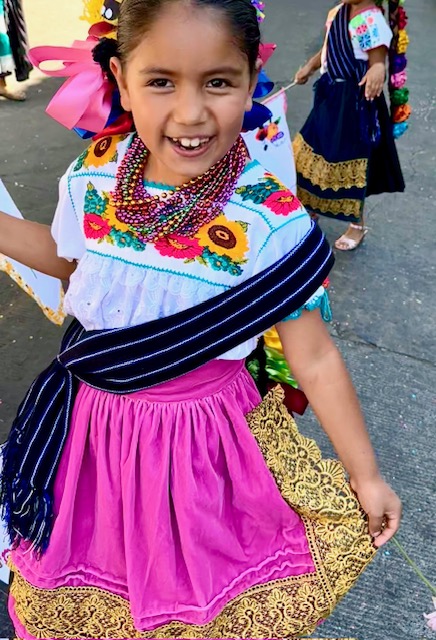


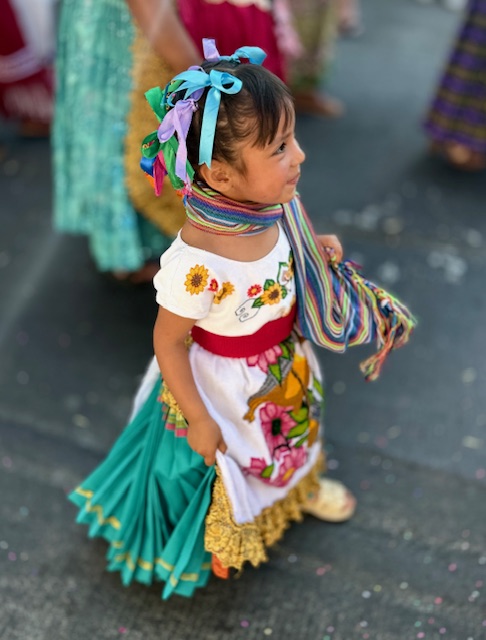
The artisans march proudly in sync, all while prominently holding and displaying their wares; their faces beaming from ear-to-ear with such great pride and joy as they slowly meander downhill, following behind their town’s sign.
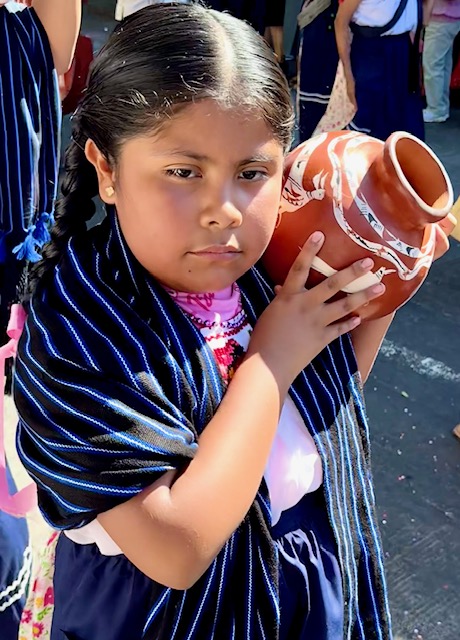
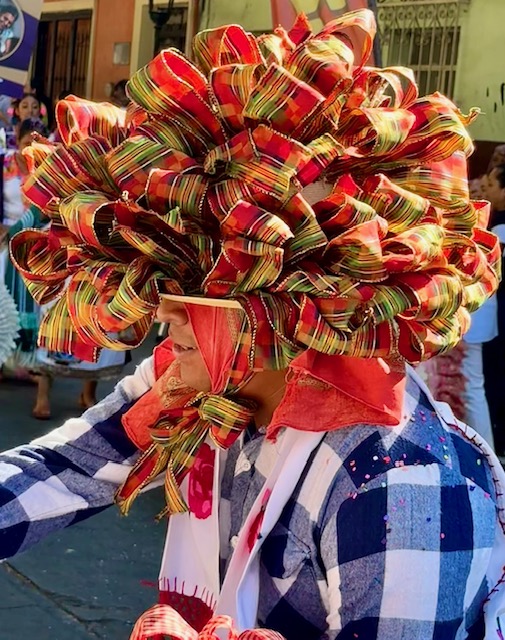


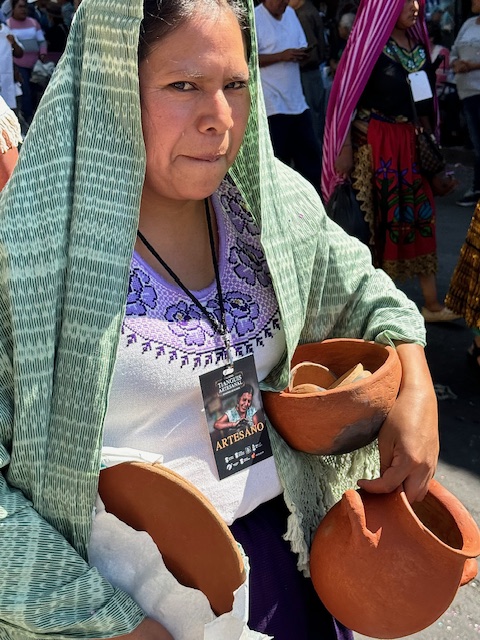
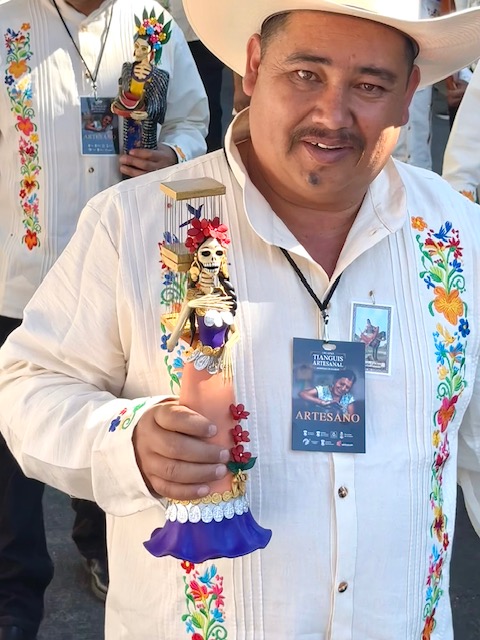

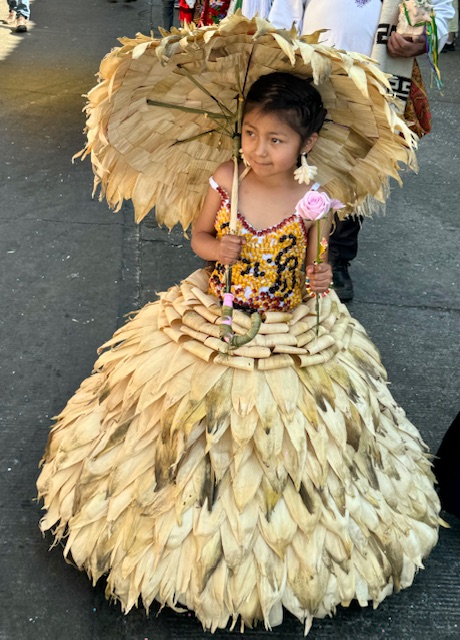
Some carry baskets overflowing with brightly colored textiles, while others balance intricately carved wooden sculptures on their shoulders for the entirety of the parade – almost two hours long.
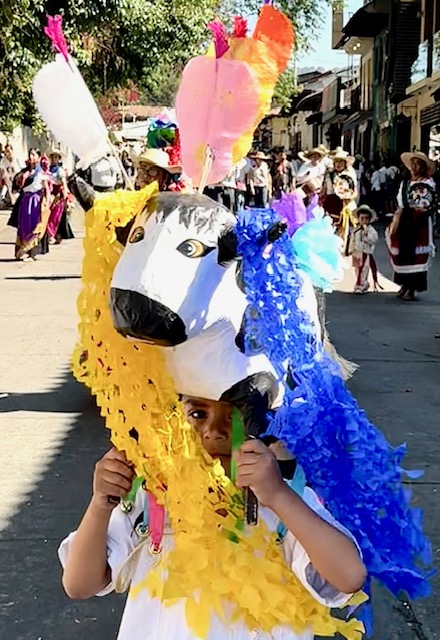

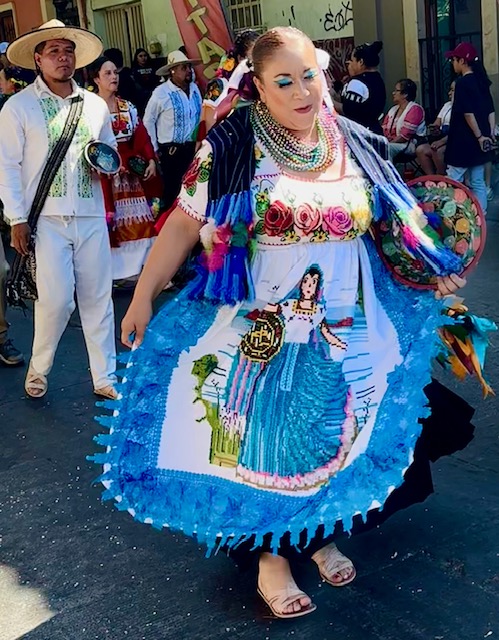
Amid all the revelry, there’s also a sense of reverence for the artisans and their craft. Each piece tells a story, their story, and is a testament to the skills and dedication of those who created it. It’s a celebration of tradition and innovation, and a tribute to the timeless artistry that defines the soul of Michoacán. I’m not normally much of a parade person, but I’d definitely return and experience this spectacle once again.
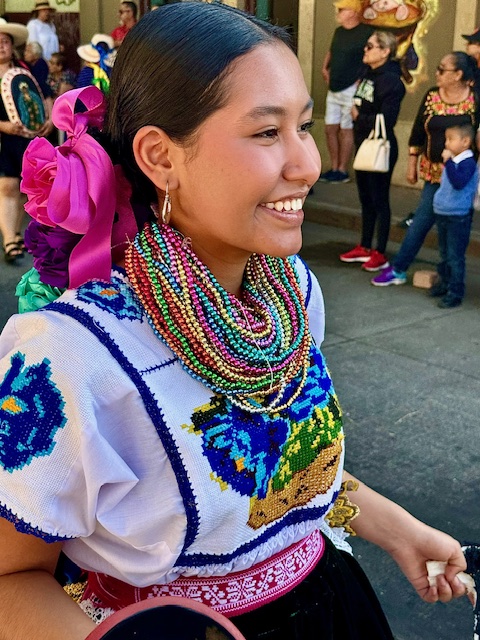
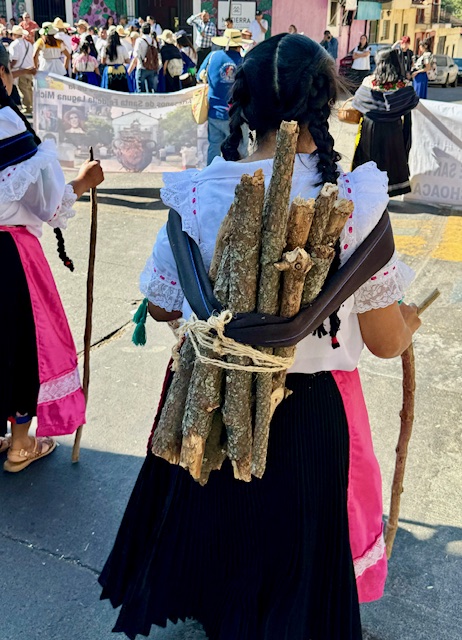
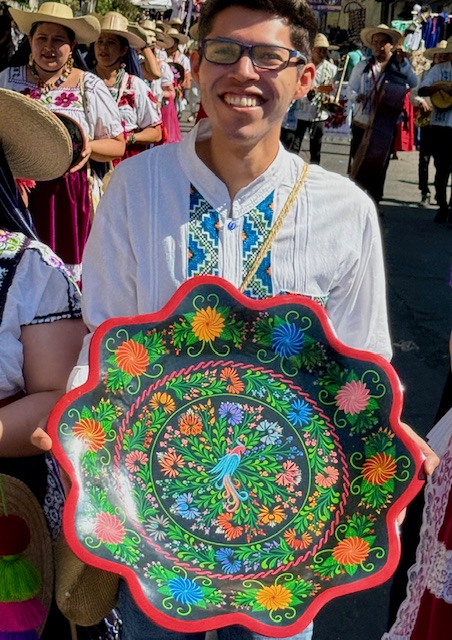
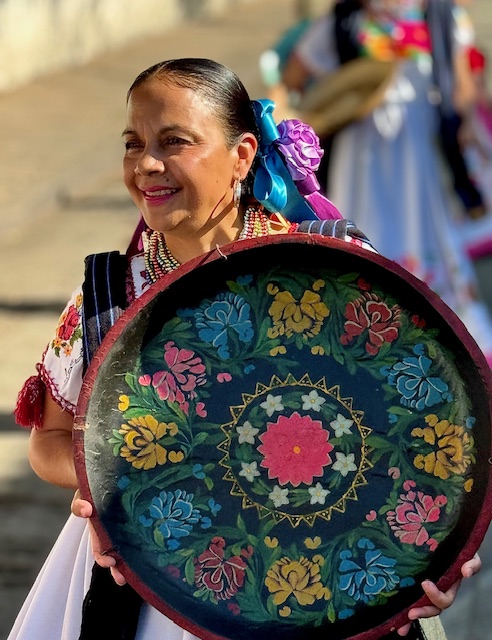
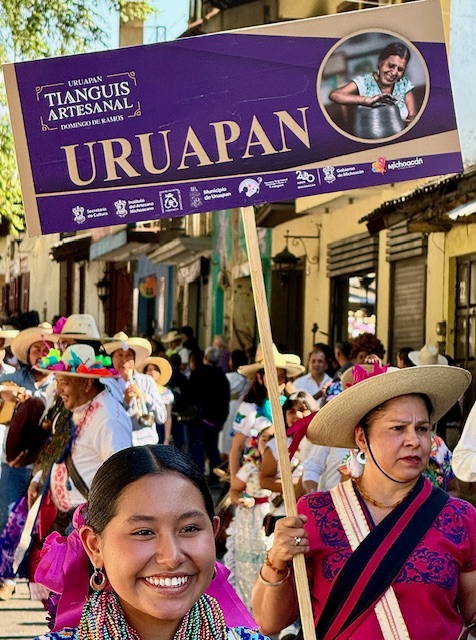
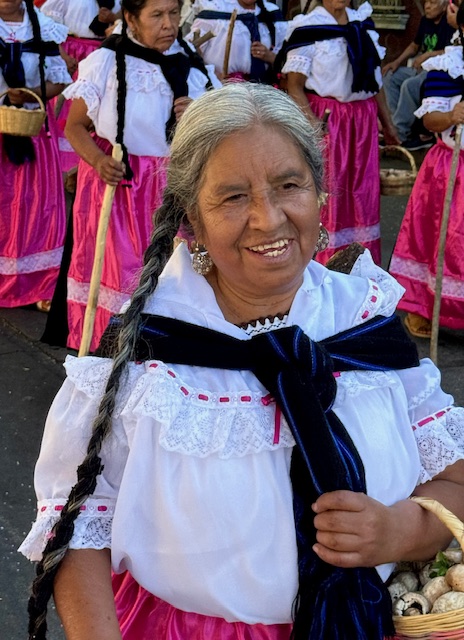
And, if you’re lucky enough to be gifted a small piece of pottery from the artisans, it’s a blessing; both David and I were blessed quite a few times; those small pieces will be displayed in our home with honor and gratitude.

But as familiar readers know, fabulous food figures in all our trips. Another doctor recommendation, Cocina M, satisfied this need. Their motto: “Nos gusta comer y beber” ~ We like to eat and drink! Amen.
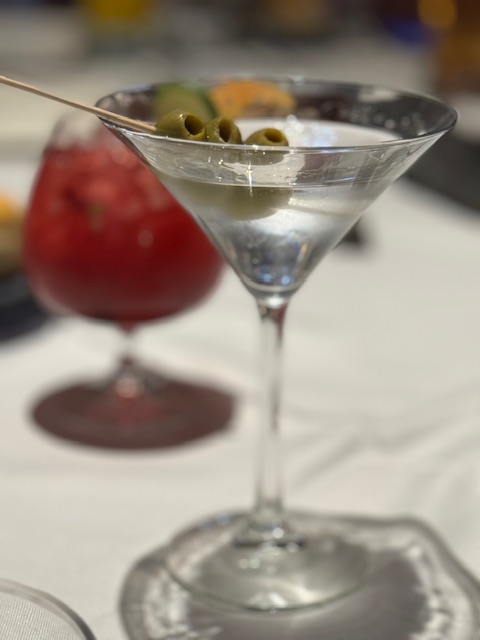
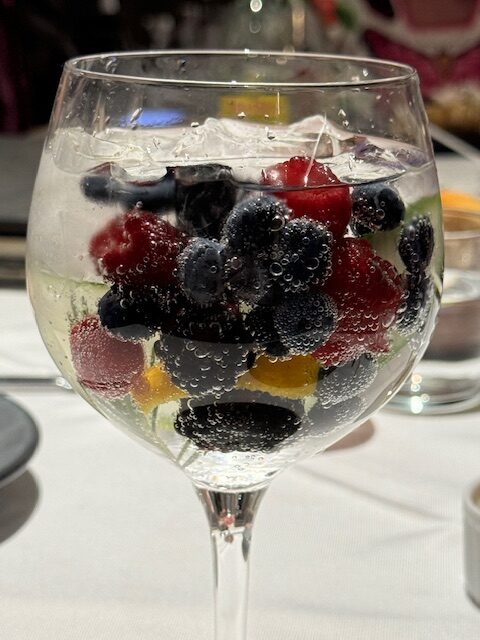
Comer y beber we did; starting from their creative mixologist to innovative fusion dishes that still maintain their Mexican roots.
Cocina M had one of their creative dishes featured in the Netflix series, “Taco Chronicles,” season 1/episode 2: Carnitas of Michoacán. The chef’s Carnitas Gyozas with sweet potato puree and drizzled with a tamarind demi-glace were divine and sublime.
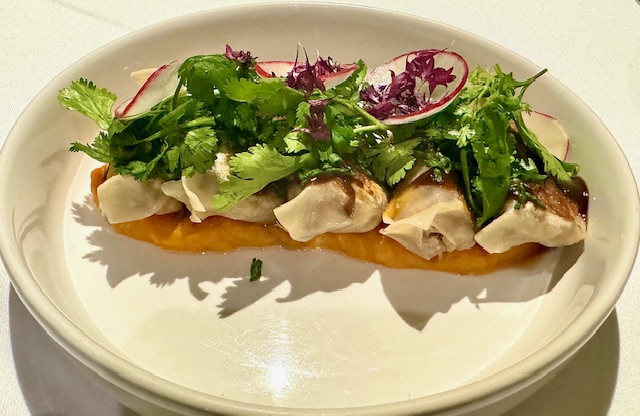
Other fantastic starters: a crispy potato-filled cannoli stuffed with coconut crab made with a heavenly combo of aioli, salsa and avocado.

Octopus and Potato Crispy Tacos served with fried beans and avocado sauce and pickled onions.

My exciting entrée was a succulent Crispy Pork Shank with a pasilla chili teriyaki sauce glazed over the big hunk of pork shank. I could have licked the plate. I’ve got to play around with recreating this glorious glaze at home.
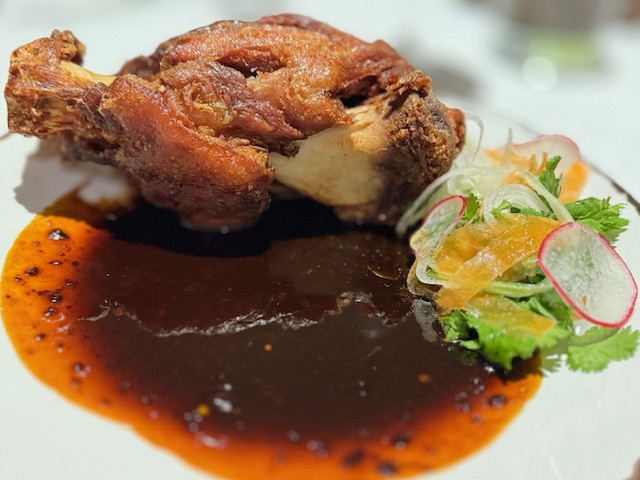
David’s Valenciana Rice is Cocina M’s stellar version of paella, flavor-packed with: Saffron rice, shrimp, octopus, Spanish chorizo and pork rinds.

The restaurant is architecturally stunning with a beautifully curated Michoacan art-inspired décor; inviting guests to dine leisurely, and tastefully linger over each and every marvelous bite.
A final side trip took us to the tiny pueblo of Pomacuarán and its Parish of San Miguel Arcángel de Pomacuarán, again founded by Friar Juan de San Miguel. The architecture reflects the Spanish colonial style as was originally built in the 1500s by the Franciscans; its current building dates from 1672.
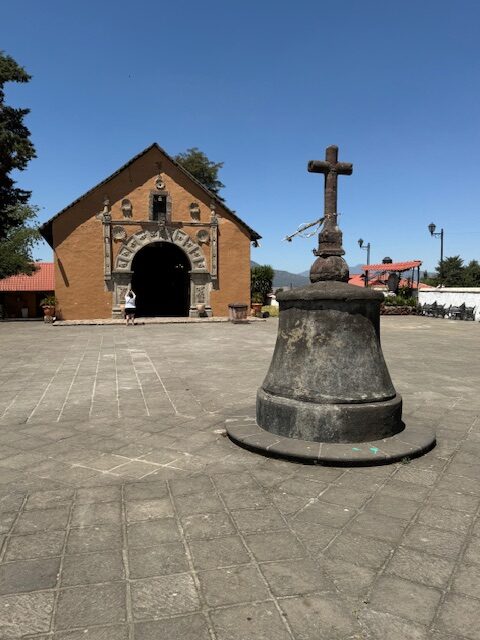
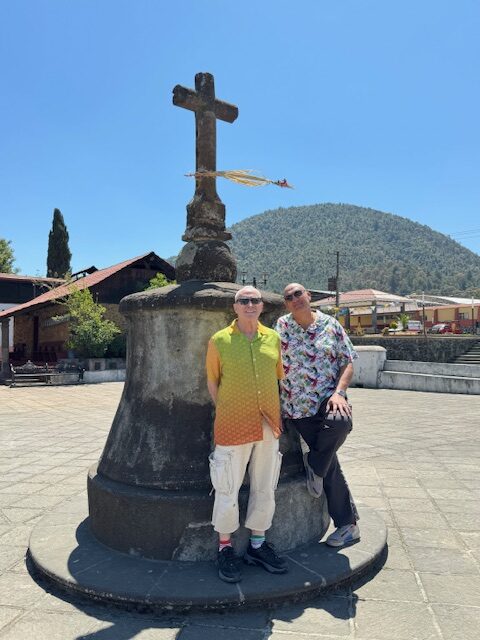

Walk inside the church and behold its magnificent wood-painted ceiling that was common to churches of the period. There’s a large plaza that’s the community center of village life (pop. 1,780). An original cross from the 16th-century dominates this peaceful, sunlit courtyard .
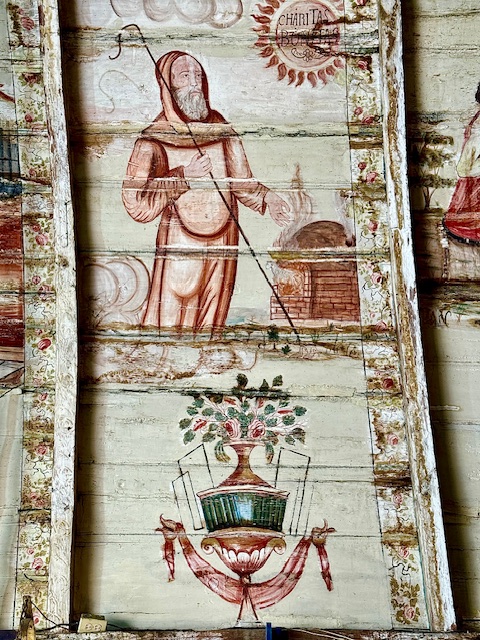
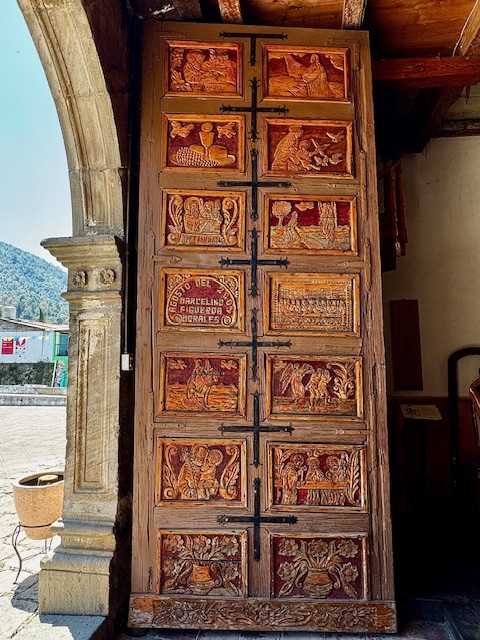
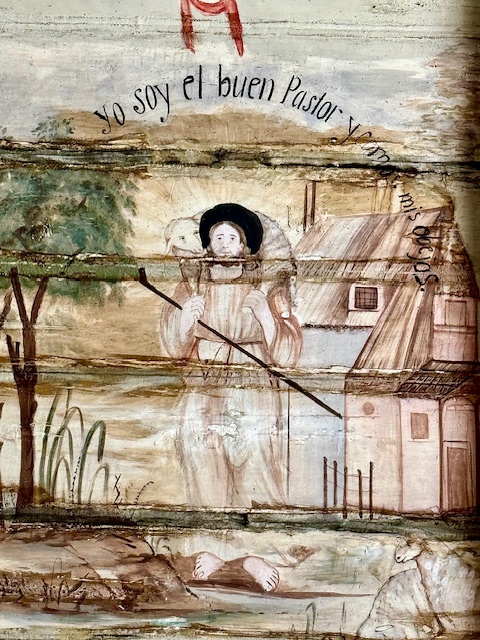
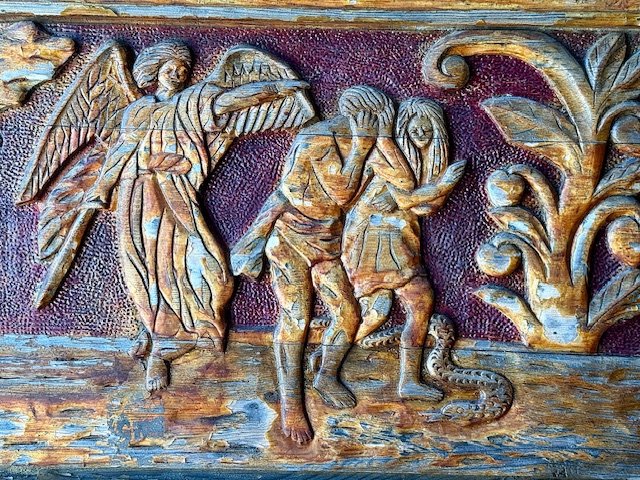
Only the sound of children performing and studying their catechism brought life to this otherwide quiet village in the Michoacan Highlands.
And so ends a short, but wonderful road trip that enabled us to experience this unique region, its people, customs and traditions, and provide more great Mexican memories.
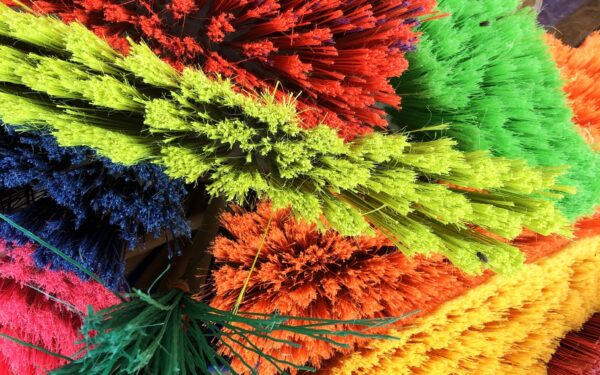


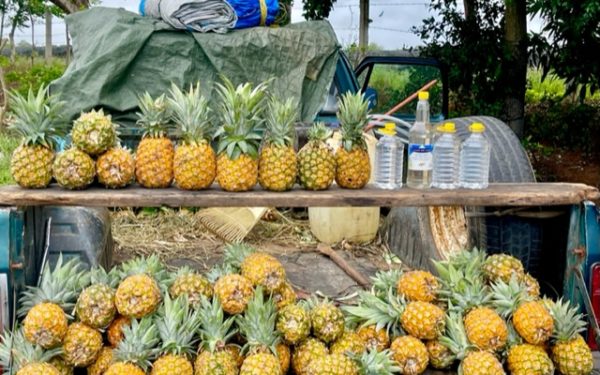
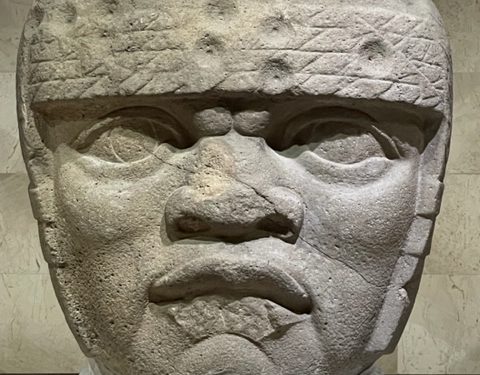
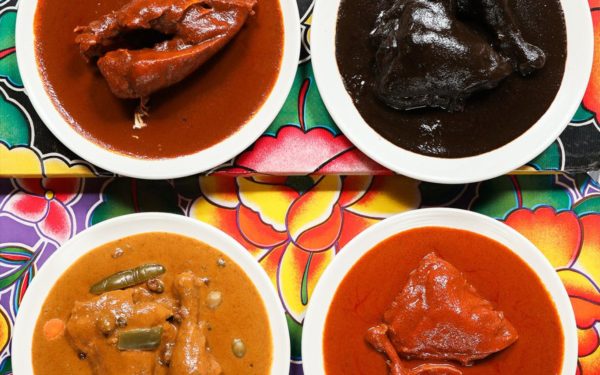
Thank you for this wonderful look at Uruapan’s Artesanal Tianguis, Domingo de Ramos, Sergio. I was unaware of the broad scope of this event. With such remarkable talent on display, it must have been difficult to choose what would go home with you and David. The exception, of course, being the Devil’s Car David has been dreaming about for years. As always, the photos bring your enchanting narrative to life. Such vibrant colors. Such a proud people. Thank you again for an exceptional Musings. One that truly highlighted the indigenous peoples of Mexico.
What a magnificent trip!!!!!
I don’t know, the food looked great, but this time the arts & crafts win 👍 Great trip❣️
Just found this post. As usual, a thorough sharing of your adventure! Do they still throw out free examples of their wares during the parade? Did you walk through the huge park with all of the water features including hatchery? For some reason you are still in my junk mail. Gotta get you out of there..Welcome home from your further travels to view the eclipse.